







 |
 |
 |
 |
 |
|||
 |
 |
 |
stone in church and cathedral constructionrelated page: |
|
|
|
|
||
franceon first arriving in France - driving Germans
in France France’s western isles: Ile de Ré Marianne - a French national symbol, with French definitive stamps the calendar of the French Revolution the 6th bridge at Rouen: Pont Gustave Flaubert, the French umbrella & Aurillac the forest as seen by francois mauriac, and today after the whirlwind, in les landes the Citroën 2CV: cathedral labyrinths and mazes in France Pic du Midi - observing stars clearly, A64 Carcassonne, A61: world heritage fortified city Marianne - a French national symbol, with French definitive stamps the calendar of the French Revolution mardi gras! carnival in Basque country what a hair cut! m & french pop/rock country life in France: the poultry fair |
compression, stress and strengthWell, I suppose we all know what stone is, it’s that stuff that’s all over the place on this fascinating planet. Well, that’s mostly what I know about it anyway; but I hear tell that there are people who spend their whole lives studying stuff like stones, so I imagine there must be a lot more to it than that. (Maybe eventually, I will find an enthusiastic expert who can write some plain English on the subject for me.) Just one or two notes relevant to cathedrals. The stone needs to be hard enough to stand up, and to last a thousand or two years, and easy enough for a medieval craftsman to work with rather primitive tools. Stone is very strong in compression, and only about a tenth of that strength in bending and sheering (tension, stretching), while the medieval mortar is about a tenth of that sheering/bending strength.
Notice the greyed stones in the arches of diagrams A and B. On the arches, you will see a small triangular diagram. If nothing were holding the shaded stone place, it would fall to the earth; but locked in place, weight (force) is coming down on the stone (the stone, of course, also has some weight). That force is directed mainly along the stone. As you will see, the stone in the pointed arch [A] is at a more vertical angle than the stone in the Roman (rounded) arch [B]. This means that a greater proportion of the load on the stone is transmitted downward and less outward than is the case with the rounded arch. The differing forces are represented by the differing lengths of the sides of the triangle, and these can be calculated. Be aware that in general the wider the span, the greater the forces. The greater outward force with rounded arches explains why earlier buildings, before the gothic, required thick, heavy walls to stop the pressures bursting them outwards. The more efficient, pointed arch led to much lighter and more open structures. Those nice vaults under which you are standing can be estimated to weigh towards 300,000 kilograms for the quadripartite vault, and towards 400,000 kilograms for the sexpartite [2] - a nice headache for you if the medieval craftsmen were slacking on the job. Note that the sexpartite tends to cover the equivalent of two quadripartite vaults, thus making the overall weight of sexpartite vaults less and thereby reducing the stresses throughout the structure. (Bourges can be thought of as a very special, high-tech cathedral.) Moving to diagram C above, you will note that, at the overhang there are forces inclining the stone to bend downwards. Tensile forces are generated at x and compressive forces are generated at y, and thus the pressure is to pull the stone apart at x and tear it apart. In the arch stones, similar forces are being applied. Note that, were the stone at C to be made of butter, it may tend to sheer rather than bend (see also en délit). building stoneHere discussed are some of the stones used for building churches and cathedrals. For the most part, the stone is quarried, or even mined locally, but when its qualities enable greater ability in shaping and carving, stone is transported to other regions, and even other countries, as in the case of Caen stone limestoneLimestone is a common sedimentary rock, found all over the world - about 10% of all sedimentary rock is limestone. It is mainly made of skeletal fragments of marine organisms such as molluscs, forams and corals. Its composition is mostly of calcite and aragonite, different crystal forms of calcium carbonate (CaCO3), and is generally light-coloured. Because it is laid down as sediment, limestone has a generally horizontal grain. When the quarried and shaped stone is laid in a building or wall with its grain parallel to the ground, the stone is termed as being au lit (in the bed), as it is very strong in compression. When the grain is posed (arranged) to be vertical, it is described as being en délit, and is much weaker and liable to shatter. Limestone comes in different densities, and so different hardnesses and weights. The hardest limestone was used for the structure of the building : towers, buttressing, outer walls and pillars that will hold up the roof. Dense but fine-grained limestone that can be carved in great detail was used for the many statues. Softer and more porous limestone, and therefore light but strong, was used for the wide expanses of vaulting that provides both a decorative ceiling and protection from the elements to the nave below. Limestone's structure is moderated by the way in which it is laid down. The deeper the limestone bed, the more pressure it comes under, thus making it denser and heavier. A limestone's geographic location can be determined by microanalysis of which microfossils it contains : fossils of plankton, such as orbitolites complanatus, and other very small organisms. As usual, definitions are never black and white. Limestone is generally accepted to have at least 50% (marine) animal bones or skeletal fragments. Chalk, as used for marking out hopscotch or by teachers at blackboards, approaches 100% skeletal fragments. So you're writing with other people's no longer required bones! I am told that Beavais cathedral is built of stone that is nearer to chalk, which does not help its stability. When limestone metamorphoses, changing state under the influence of heat and/or pressure, it becomes marble. Limestone is very common in architecture. Readily available and relatively easy to cut, limestone can be long lasting unless subject to modern pollutions, the chemicals in limestone can be readily dissolved by acidic solutions and water (acid rain). The Ancient Egyptians used limestone to clad the Great Pyramid of Giza, a wonder of the ancient world. More recently, many medieval churches and castles in Europe are made of limestone. In France, the best limestone was and is Caen stone (pierre de Caen). It is a light creamy-yellow Jurassic limestone quarried near the city of Caen in north-western France. This fine grained oolitic limestone is homogeneous, and so suitable for carving. Caen stone had been first used for building in the Gallo-Roman period. Production restarted from open cast quarries in the 11th century. This stone was shipped to England by the Normans using it to build parts of Canterbury Cathedral, Westminster Abbey and the Tower of London. More recently, Caen stone was used for parts of the clock tower at the Houses of Parliament, commonly called Big Ben. In recent times, Caen stone has also been exported to America and the Middle East, but since 2004 Caen city council has limited its use and export by only permitting 9,000 tonnes of stone a year. Portland stone is a similar fine quality limestone found in southern England used there for prestigious buildings such as the Tower of London, St. Paul's Cathedral, the British Museum, Port of Liverpool Building, and many others. The ability to carve limestone was developed to a very high level in medieval France, as illustrated by the development of tracery, of tympani above the west door of most cathedrals, and much else in the cathedral's statuary.
|
|||||||||||||||||||||||||||||||||||||||||||||||||||||||||||
Right: Close-up of part of the galuche (and mortar) wall at Mezos church |
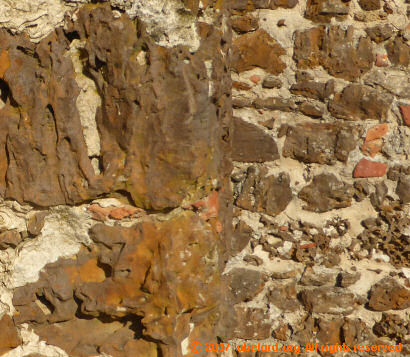 |
As at Clermont Ferrand, Agde is distinguished by the dark grey, almost black volcanic rock used in many of its buildings. This rock comes from Mont Saint-Loup, a nearby extinct volcano. The Cathédrale Saint-Étienne d'Agde is a 12th-century fortified church, complete with machicolations, built on the site of a Phoenician temple.
The first cathedral, hardly completed, in the 8th century was rased to the ground by Charles Martel. He did this, as in other towns such as Beziers and Nimes, to prevent the Saracens, whom he had newly ousted, from using the building as "a den". His son, Pepin le Bref, finally conquered the region in the 750s.
The next, Romanesque, cathedral, finished in about 1220, was built by the bishop of Agde who was also its count, its temporal lord. This was common in towns of the Midi at that time. The cathedral's fortified nature was preparation against invasion from the nearby Mediterranean Sea.
The Wars of Religion in the 16th century were a source of damage as the Calvinists burnt sacred relics, and similar profanities occurred during the French Revolution. Then the cathedral became a 'stable' for pigs, while the last bishop of Agde died on the scaffold in Paris, refusing to take the Republican oath and "dishonour his old age".
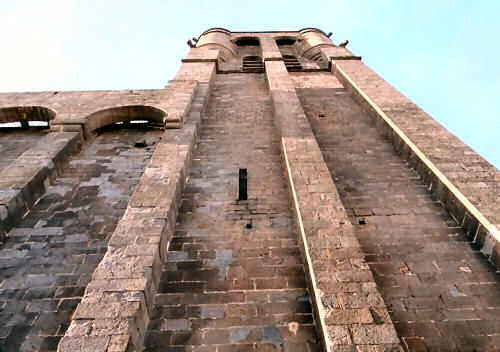
Agde cathedral east facade.
Things become a bit complicated now as long-term processes of heat, pressure and submergence in water change the nature of materials. sarsen stones are well known from their use in the Stonehenge monument. These stones are sandstones that have become silificated, that is glued together under anaerobic and wet conditions. Various other materials besides silicates can be involved in these processes. Unlike crumbly sandstone, sarscen stones are very hard, maybe Mohs 7. These processes can occur in limestone and other materials, leading to all the wondrous differences we commonly call mud, earth and rock. Petrified wood, various crystal forms called jewellery, nodules of flint, fossils, agates and so on, these humans use for their delight and decoration.
Llandaff Cathedral has a long and chequered history, an advantage with buildings that have gone through hard times is that you see views of their innards and bone structures. Llandaff is the cathedral the second-most damaged by Germany during the Second World War after Coventry Cathedral.
For centuries, Llandaff was in a poor area, and was despoiled by Henry VIII, Cromwell's lot, greedy pastors, and sheer poverty. The tide turned with the industrial revolution and the discovery of coal in the valleys. Since when, with the interruption of German vandalism, the cathedral has been on the up. This roller-coaster of history, the cathedral is now a hodgepodge of variety, as shown in the paragraph below. This variety is not uncommon, as the accretions of history for like moss upon a rock.
"Like the entire west front [of Llandaff Cathedral], the bishop is carved from the distinctive creamy-yellow Dundry stone from near Bristol. Many different types of stones were used in the building of Landfall, including some materials not to be found elsewhere in Cardiff. The early Norman parts of the Cathedral use Sutton stone (from Ogmore and Southendon) or Radyre stone with river pebbles. Later the greyish lias limestone from southern Glamorgan was introduced. The nineteenth century reconstruction used Bath stone, oolite from Chipping Camden in Gloucestershire, stone from Wiltshire, Radyr, and the Forest of Dean as well as some Caen stone from Normandy. The upper part of the nineteenth century spire is of a yellowish stone from Rutland. In the David Chapel, Doulting stone from Shepton Mallet was used with river pebbles from the Taff and recycled stone from the demolished cottages in Llandaff. Portland stone was used for the foundation of this chapel and for the panels of inscribed battle honours on the east wall." [Lambert, pp.117-8]
![]()
Another church built with a wide variety of stones, in this case marbles, is St Margaret's Church, Bodelwyddan, Gwynedd in North Wales, and nicknamed the Marble Church.
The church has fourteen varieties of marble, including
Cosmati is a form of mozaic flooring (pavement) found in some English cathedrals, such as Westminster Abbey and Canterbury cathedral. It was developed in the 12th and 13th centuries by seven generations of the Cosmati family, a Roman family of architects, craftsmen, and mosaic workers. Cosmati work was fashionable in the 12th and 13th centuries, being used to decorate tombs, pavements, and furniture in churches throughout Italy. The style was used at Westminster Abbey for the flooring on which the royal coronation takes place, and in Canterbury cathedral to mark the location of significant events - the death of Thomas à Becket and Edwar the Confessor.
The original palette of materials employed for both the Romanesque tesserae and the slabs of opus sectile comprised purple porphyry from Egypt, green porphyry from Greece, white Carrara marble from Italy, black Tournai marble from Belgium, and pale grey Thassos marble from Greece. Most unusually, many of the mosaic panels are individually edged with thin strips of latten (brass): some are 19th-century replacements, but others are certainly primary. All are now tarnished and obscured by floor-polish but, like medieval funerary brasses, these fillets would originally have been gilded. The narrow bands of mosaic in the borders were also subtly elaborated by combining latten fillets of three different thicknesses.
[From the-past.com]

Cosmati pavement at Canterbury cathedral
in front of the shrine of St Thomas in the Trinity Chapel
c.1182-1184
At Westminster Abbey, the Cosmati pavement was commissioned by Henry III, and completed in 1268 as an intricate mosaic floor of marble, stone, glass and metal in front of the High Altar. The pavement was hidden under carpet and thus away from public view from the 1870s until a two-year programme of conservation work was completed by the Abbey in 2010. This included coatings of microcrystalline wax. Now but occaisonally, and on paying £15, visitors are allowed to walk on it in their socks (shoes abrade, and the moisture of bare feet is acidic and so damaging).
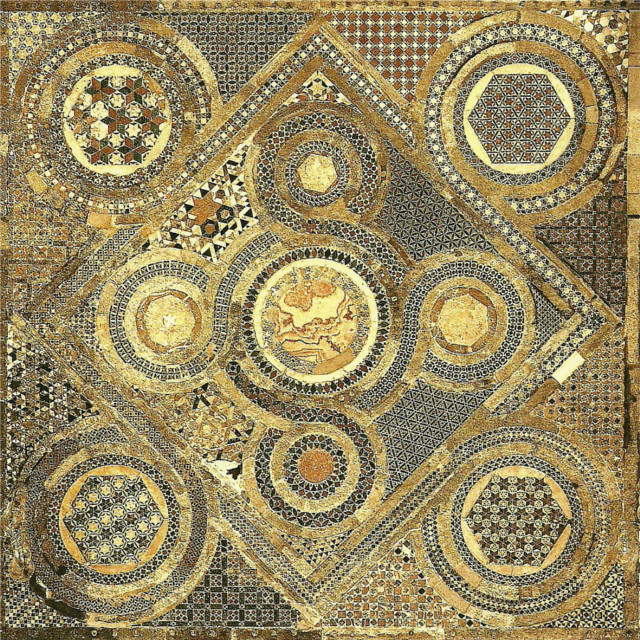
Cosmati pavement at Westminster Abbey, 1268

Part of the restored Cosmati pavement, Westminister Abbey
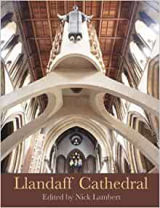 |
Seren, 2010, hbk £18.75 [amazon.co.uk]{advert} ISBN-10 : 1854114999 |
||
| St Margaret's, Bodelwyddan: the Marble Church | |||
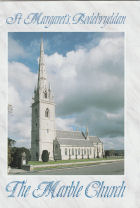 |
St Margaret's, Bodelwyddan, 1997 pbk, 16 pages, illustrated, plan, list of vicars. €2,45 This pamphlet is not recommended to buy. Very poorly written and illustrated. |
||
| Mohs hardness | mineral | absolute hardness |
| 1 | talc | 1 |
| 2 | gypsum | 3 |
| 3 | calcite | 9 |
| 4 | fluorite | 21 |
| 5 | apatite | 48 |
| 6 | orthoclase feldspar | 72 |
| 7 | quartz | 100 |
| 8 | topaz | 200 |
| 9 | corundum | 400 |
| 10 | diamond | 1500 |
| abstracts | briefings | information | headlines | loud music & hearing damage | children & television violence | what is memory, and intelligence? | about abelard | ||
© abelard, 2017, 15 october the address for this document is https://www.abelard.org/france/stone-in-church-and-cathedral-construction.php 2170 words |